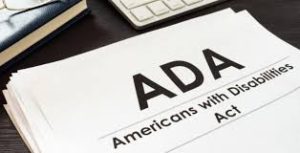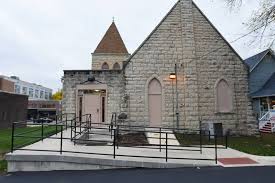Call to Action for Religious Institutions
Author: Sheri Denkensohn-Trott
July 26th was the 29th anniversary of the Americans with Disabilities Act (ADA). This monumental legislation, one that impacts the civil rights of individuals with disabilities, was groundbreaking when it was passed in 1990. Prior to its passage, the Rehabilitation Act of 1978, only required public  institutions to be accessible to individuals with disabilities in their programs and activities. The ADA broadened coverage to include employment, public accommodations, and later websites and other technology through addition of Section 508 to the Rehabilitation Act.
institutions to be accessible to individuals with disabilities in their programs and activities. The ADA broadened coverage to include employment, public accommodations, and later websites and other technology through addition of Section 508 to the Rehabilitation Act.
The ADA included a specific exemption for places of worship (i.e. churches, synagogues, mosques, et al.). The reasoning recognized that many buildings where worship took place were old and should not be mandated by law to renovate and change policies and procedures so that individuals with disabilities could pray, meditate, or whatever type of activity they wanted to engage in.
Since 1990, many places of worship have taken diversity and inclusion seriously and have made their facilities accessible. This includes, but is not limited to, access to the  altar, bathroom, entryway, and programs that are accessible for those that are blind and deaf. These are major achievements that should be applauded. There are individuals all around this country that donate their time and resources to places of worship and many religious institutions have used donated resources to support making religious buildings more accessible for everyone, including individuals with disabilities.
altar, bathroom, entryway, and programs that are accessible for those that are blind and deaf. These are major achievements that should be applauded. There are individuals all around this country that donate their time and resources to places of worship and many religious institutions have used donated resources to support making religious buildings more accessible for everyone, including individuals with disabilities.
Although places of worship are not required to be accessible for individuals with disabilities, it is something to strive for. In general, the cornerstones of most religions are non-discrimination and openness to all. No individual should be left out. Everyone has the right to be included and pray in the manner in which they want at the institution where it is applicable to their beliefs.
It is time to issue a challenge. Next July will be the 30th anniversary of the ADA. A banner year. There is a year for those religious institutions that still have a ways to go towards becoming fully inclusive and accessible to make a start. To do so in the right way, the best course of action is to bring to the table individuals that are knowledgeable about the needs of people with disabilities and can help critique construction plans, review procedures, and help leadership of religious institutions figure out what they can do within their budget and how much more they can do if they have a fundraising campaign for specific accommodations. This is often people who have disabilities.
individuals that are knowledgeable about the needs of people with disabilities and can help critique construction plans, review procedures, and help leadership of religious institutions figure out what they can do within their budget and how much more they can do if they have a fundraising campaign for specific accommodations. This is often people who have disabilities.
As individuals in our society live longer, there will be even more individuals with disabilities. These individuals will want to continue to go to their places of worship. Many have done this for their entire lives. There is no reason that just because they have aged and use a wheelchair, or other mobility device, that they cannot attend services, mass, or whatever gathering is occurring.
Go forward and do it. Let’s look forward to honoring religious facilities in their progress. I know it is possible. And it is the right thing to do.

